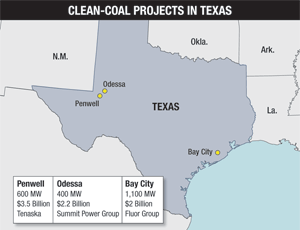Texas could become the nation�s leader in clean-coal technology, with the Texas Commission on Environmental Quality recently giving its approval to three such projects. The powerplants, though, face some opposition from neighbors opposed to the new coal plants�clean or not.

On Dec. 14, the TCEQ gave an air-quality permit to Omaha, Neb.-based Tenaska Trailblazer Energy Center, allowing it to build a 600-MW, $3.5-billion clean-coal powerplant in Penwell.
On Dec. 29, the state agency granted an air-quality permit to the Summit Power Group of Bainbridge Island, Wash., clearing the way for the power producer to proceed with a 400-MW, $2.2-billion coal-fired powerplant near Odessa.
In September, the commission approved the White Stallion Energy Center, a $2 billion, 1,100-MW facility, in Bay City.
Irving, Texas-based Fluor Corp. is providing engineering and design work on the Tenaska Trailblazer project. Proponents claim that up to 90% of the CO2 can be captured. The carbon-capture technology would be based on Econamine FG Plus, Fluor’s proprietary amine-based system that exposes the flue gas to an amine liquid solvent with the capacity to absorb CO2; it then gives up the CO2 through a controlled stripping process for capture to send off for enhanced oil recovery or deep sequestration. The CO2 can be injected into older oil wells and acts as a solvent to liquefy and push oil out of the rock formations.
“So you get higher production out of the oil well, and in the process you are geologically sequestering CO2 underground,” says Don Broeils, vice president of Fluor’s Solid Fuels Business Line.
Help Wanted
The Summit project is scheduled to begin construction in 2011, with operations expected to start in late 2014. At the peak of construction, some 1,500 workers would be needed. Siemens Energy, headquartered in Erlangen, Germany, is providing gasification technology, power generation and controls.
Construction on the Tenaska project could start sometime this year and last until 2016, when the plant would begin generating electricity, officials say. At building peak, some 1,500 workers could be employed.
“There continues to be a need for base-load generation, and one way to provide that is by coal,” says Jeff James, Tenaska director of business development.
The White Stallion project’s proponents say that construction of the $2-billion plant would require more than 2,000 workers.
But those opposed to the plants say the state already is brudened with a high proportion of other carbon-dioxide-spewing coal-fired powerplants, refineries and factories.
Drew Edmondson, Oklahoma attorney general, in a letter to EPA officials in May, voiced concern over efforts to “rapidly permit and construct” coal-fired plants in Texas, because “emissions from these new sources will adversely impact air quality, public health and economic growth in Oklahoma.”
The Environmental Protection Agency began to enforce new rules for issuing permits to facilities that emit greenhouse gases on Jan. 2, 2011.
A dozen states have filed suits challenging the greenhouse-gas rules, but Texas so far is unrivaled in its emphatic refusal to comply with the new directives from Washington.
This article was originally appeared at ENR.com.

Post a comment to this article
Report Abusive Comment